Trunk Main Risk & Consequence Modelling Project (2016)
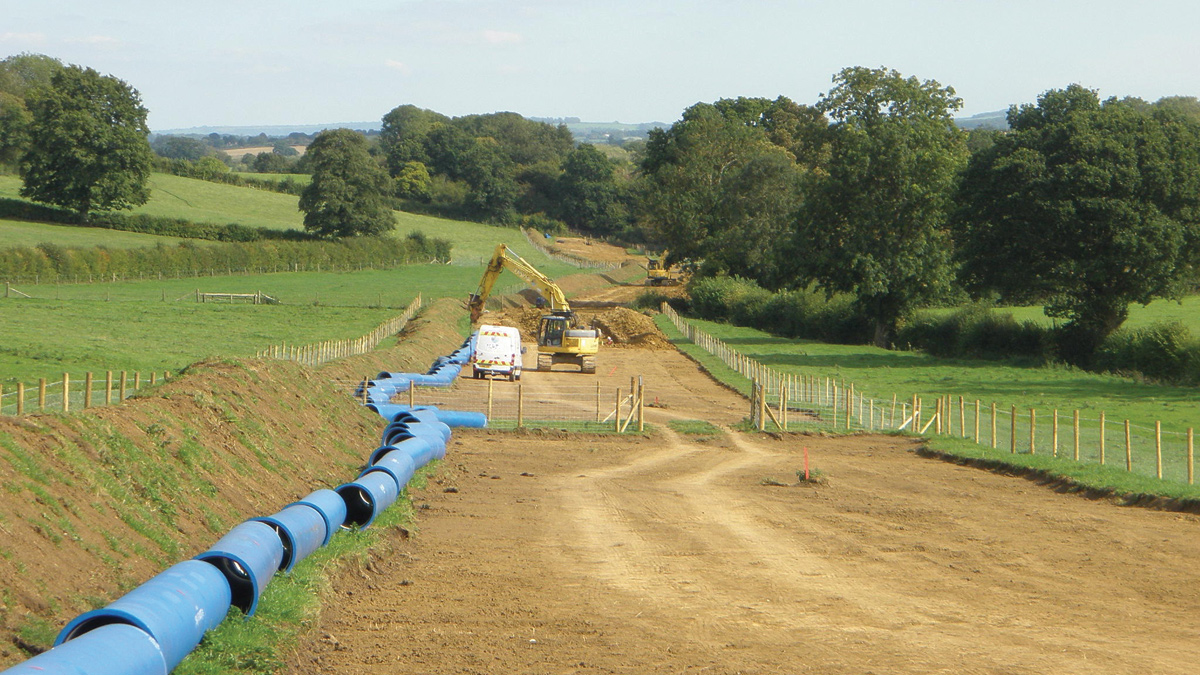
Pipe laying - Courtesy of Mouchel Consulting
Northern Ireland Water (NI Water) has responsibility for providing potable water to almost 1.8 million people across Northern Ireland via some 27,500km of watermains. The company currently operates almost 2,300km of trunk and strategic watermains which represent 8.3% of its potable water network (trunk mains are defined as those with a 300mm nominal diameter and above; and strategic mains are defined as those smaller than 300mm diameter but used to transfer supply between reservoirs which are affected by operational, structural or hydraulic issues). In response to its Utility Regulator, the Northern Ireland Authority for Utility Regulation (NIAUR), NI Water has identified a number of actions to be implemented over its current six year price control period, PC15, running from 2015 to 2021. These are aimed at improving its asset management capability and building upon existing strengths, and include (i) assessing trunk mains criticality to inform its base maintenance programme at mains section resolution (as opposed to full length) and (ii) linking investment decisions to serviceability and service impact, as part of the ‘business as usual’ project selection and benefits realisation process.
Project scope
To achieve these objectives, in 2014 NI Water commissioned Mouchel Consulting to assist it to develop a robust trunk main risk and consequence model to inform the criticality (high-risk and high-consequence) and prioritisation of individual sections of each trunk main. NI Water aligned the scope to support its base maintenance planning as well as other interventions on its asset base, with separate rationalisation and resilience delivery programmes. The key tasks and deliverables required from the project were:
- To review NI Water’s trunk main asset base, corporate and stakeholder data, undertake gap analysis on available asset data and formulate recommendations for further studies which would improve confidence in the model’s outputs.
- To incorporate the outputs from NI Water’s ongoing trunk main condition assessment programme into the model.
- To work collaboratively with NI Water to create a pragmatic, user-friendly model, aligned with wider industry best practice risk-based methodologies and processes and apply these appropriately in the NI Water setting.
- For NI Water to demonstrate to its utility regulator that it is implementing a suitably robust risk and consequence methodology, which will facilitate the justification of an economically efficient trunk mains capital programme for the PC15 period and beyond.
- To facilitate knowledge transfer of the methodology and model processes to NI Water’s Asset Performance Water Infrastructure Team throughout the course of the project.
The focus of NI Water and Mouchel Consulting’s approach on the project was to use available datasets in transparent and cost-effective processes which could be easily repeated or edited in the future, using updated datasets or incorporating new data as they become available.
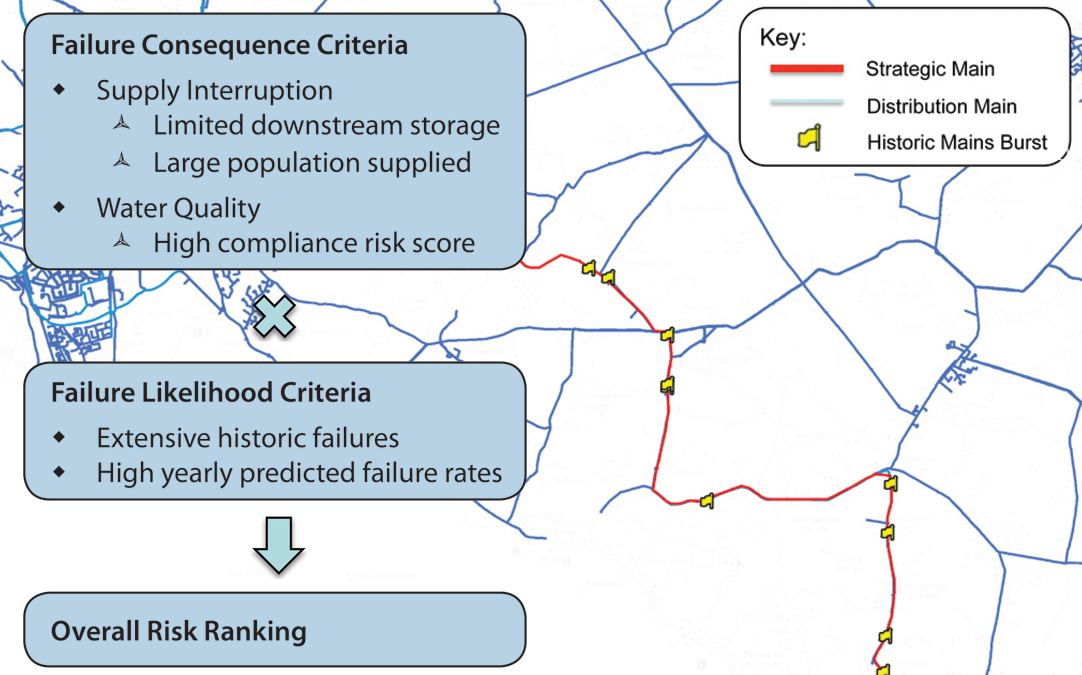
Risk ranking process – courtesy of Mouchel Consulting
Trunk main identification and data collection
At the outset of the project, the Mouchel Consulting and NI Water team worked in partnership to identify 2,300km of trunk and strategic mains from across NI Water’s potable water network for inclusion in the risk and consequence model.
The mains initially comprised some 22,000 individual pipe elements obtained from NI Water’s corporate watermains infrastructure dataset. These pipe elements were merged using geographical information system (GIS) software into 921 sections (parent lengths), based on similar mains cohorts including diameter, material and year laid.
These sections were further combined into 323 polylines which connected network assets such as water treatment works, service reservoirs and pumping stations, in order to create manageable lengths against which various spatial data could be assigned.
To obtain appropriate data for use in the model, Mouchel Consulting liaised with a range of stakeholders including Rivers Agency, Northern Ireland Environment Agency, Transport Northern Ireland, Translink, and Northern Ireland Electricity. The data collated from these sources was analysed alongside information from NI Water’s corporate datasets to inform model outputs.
The process was further complemented by a series of liaison meetings with key NI Water staff including network water distribution field managers, who oversee the potable water network. These meetings provided an opportunity to share tacit knowledge of individual system attributes and issues in their respective supply areas, thus ensuring that each trunk main system could be appropriately characterised.
Where available, additional information was also recorded on pipe condition, alternative supply routes in the event of a mains failure, air valve maintenance schedules and the location of local repair depots.
Model structure, methodology and development
In keeping with the requirement to allow the transfer of knowledge to NI Water for future in-house usage the model was designed with interactive tabs allowing user-defined variables, which provided a user-friendly and functional interface with significant configuration flexibility. The risk and consequence model was developed in spreadsheet format, with its structure intended to guide the user through the methodology and calculation process with the aid of explanatory notes and definitions for individual worksheets.
Failure frequency process: Water infrastructure failure and deterioration models are generally derived from historical failure data aligned to different pipe characteristics including pipe material, age and diameter. Using statistical regression techniques it was possible to express these failure rates as a formula for each material type. For these relationships to be statistically robust a minimum threshold of data was required.
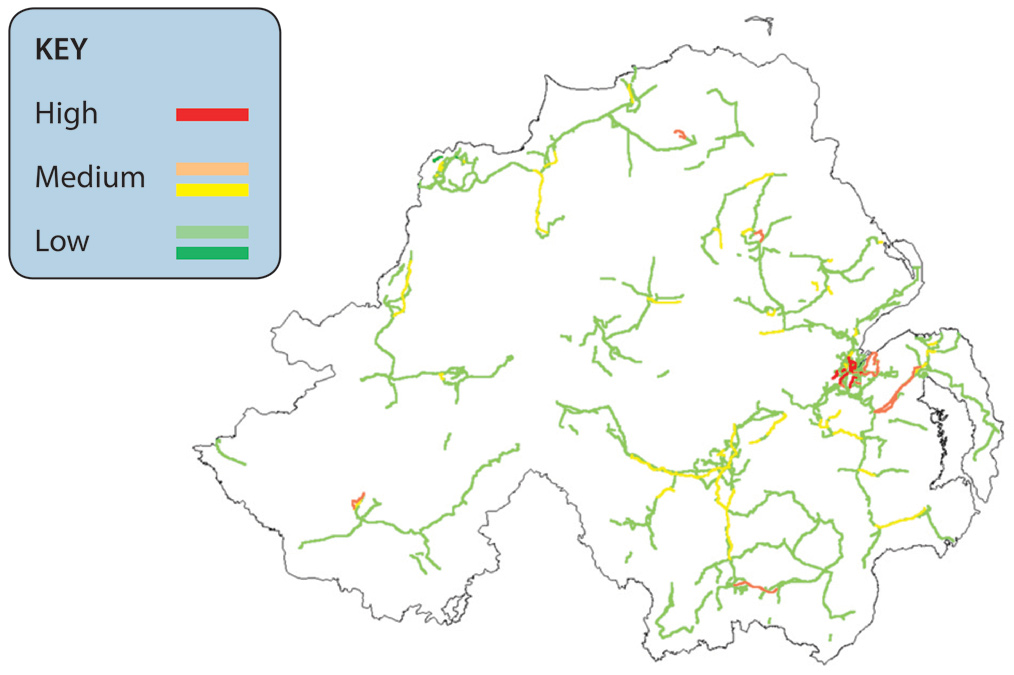
Failure frequency process – courtesy of Mouchel Consulting
Given that trunk main failures tend to be relatively infrequent events it follows that individual water utility companies generally have insufficient failure data to allow true predictive models to be formed, which was the case for the NI Water trunk mains bursts defects dataset. The project team therefore developed a set of bespoke failure formulae for NI Water.
This was based on formulae derived as part of a broader UK Water Industry Research (UKWIR) project, also carried out by Mouchel Consulting, which analysed past trunk main failure data supplied by a wide range of water companies calibrated against the numbers of bursts recorded in NI Water’s own records, so as to reflect the scale of failures observed within the region and predict failure likelihood values for each trunk main section that collectively represent similar numbers of bursts.
Failure consequence process: To derive a failure consequence score for each trunk main section, the team collated a range of attribute data under financial, hydraulic, water quality, environmental, and social criteria. Using NI Water’s strategic aims of customer, compliance and cash as overriding drivers, these attributes were evaluated with scores assigned to each trunk main section against the following consequence categories: supply interruption; discolouration; contamination; water quality; third party damage and flooding; traffic disruption; leakage; and cost to repair.
The supply interruption risk score component was calculated as the product of a likelihood component (for example: in the event of a mains burst, what is the likelihood that there will be a supply interruption event, taking into account contingency arrangements and storage?) and a severity component (for example: if there is an impact, how many people would be affected?).
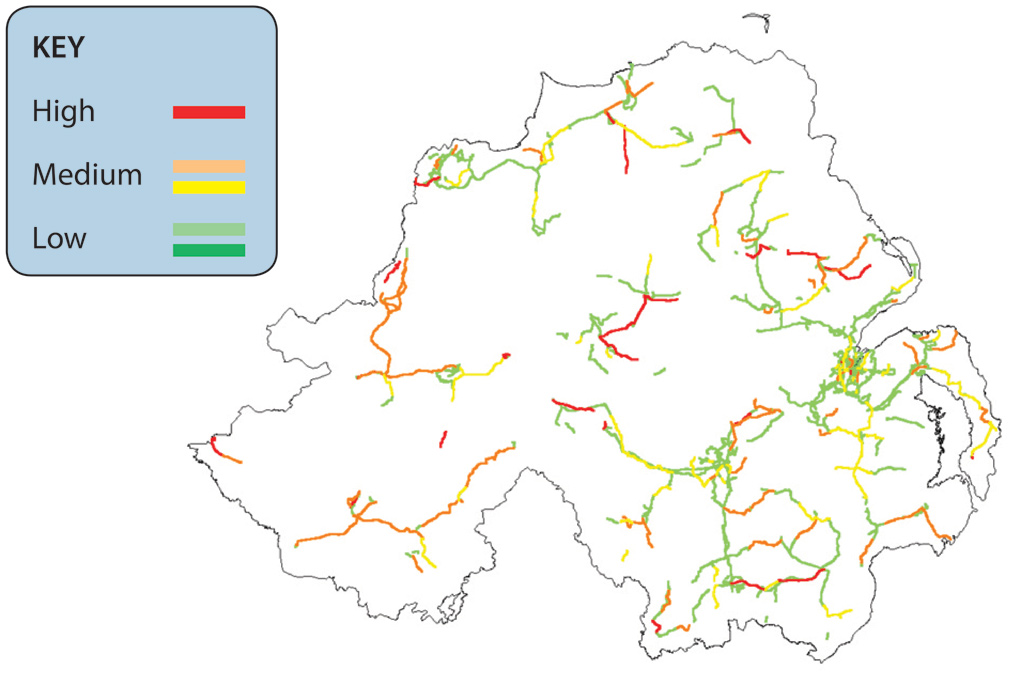
Failure consequence process – courtesy of Mouchel Consulting
User-set values: The model uses a series of factors to personalise the predicted failure likelihood for individual mains sections, based on data pertinent to each that has the potential to influence the likelihood. These include the following:
- Failure history: Recognising that once a main has failed, it is more likely to fail again than an otherwise similar pipe that has no failure history (excluding 3rd party damage).
- Surge failure risk: Accounting for failure owing to surge or transient mains pressures considered against air valve score, material type and pumped or gravity system.
- Pressure reduction: Identifying increased risk of failure due to the sudden failure of pressure reducing valves on trunk mains.
Scores and weightings: The model characterises the risks associated with the failure consequence of trunk main sections using a series of scores, representing the individual scoring categories which are combined into an overall failure consequence score. In assembling the overall score, the model uses a range of scoring threshold values and weighting factors to influence the relative importance of individual elements, which can be updated at any time should evidence emerge to support any changes.
Prioritisation: The final stage of the model involves the high-level prioritisation of trunk mains sections for further investigation or intervention. Sections were prioritised by calculating the likelihood of their occurrence and consequence/impact of their likely failure.
One of the principles used to prioritise interventions is the calculation of ‘best value’ such that it compares the benefit of investment to NI Water’s customers in terms of serviceability, with its financial cost.
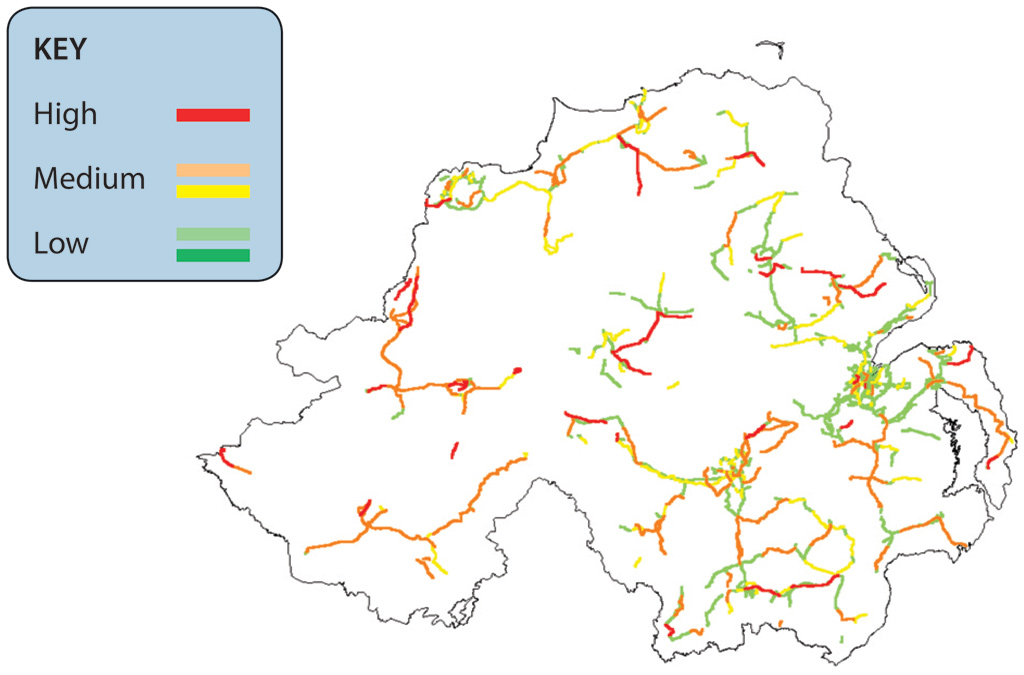
Prioritisation – courtesy of Mouchel Consulting
Delivery: The risk and consequence model delivered has equipped NI Water with a robust process for prioritising its trunk main investment. During the course of the project the team identified a number of refinements that would progressively improve the accuracy of and confidence in the model’s predictions in the future, (including proximity analysis to buildings which is currently being delivered).
The maturing of key NI Water corporate datasets and the development of its asset data sources will further improve the model’s predictive capability in the coming years.
Building on the momentum, NI Water established its Strategic Mains Steering Group to further develop its forward looking, risk based approach to prioritise its base maintenance interventions and to deliver future model improvements in accordance with industry best practice.
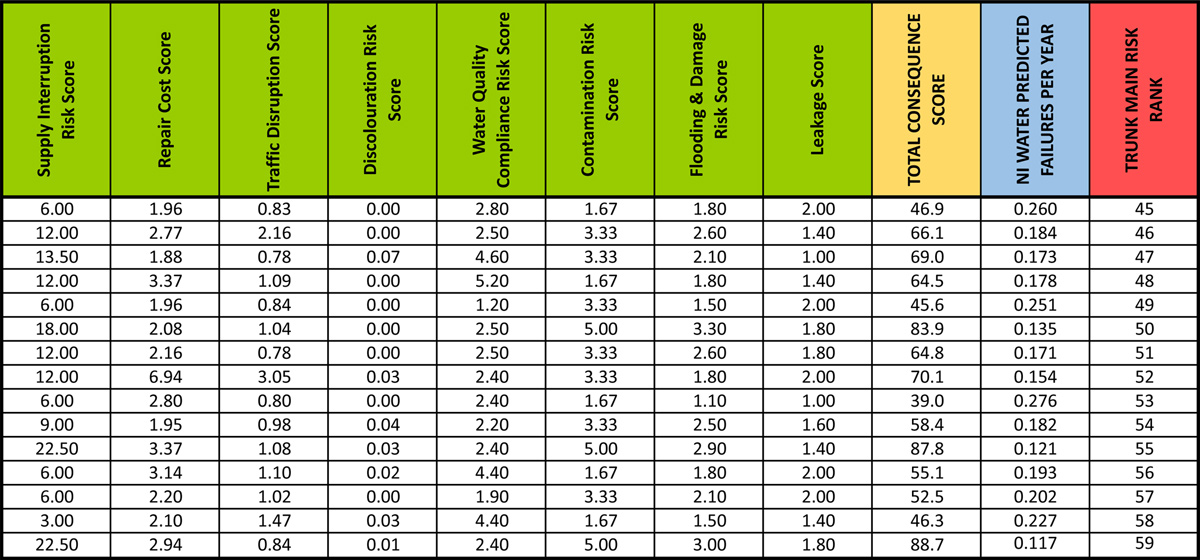
Prioritisation – Courtesy of Mouchel Consulting
Conclusions
The successful completion of the customer focussed risk and consequence model has produced a risk-ranked priority list of NI Water’s trunk and strategic mains and provided it with unprecedented visibility of the mains most in need of intervention by their relative category scores. Taking into the account the current period of constrained funding, the model greatly facilitates NI Water’s ability to progress its trunk main infrastructure sub-programme on an appropriately prioritised basis with decisions clearly linked to serviceability and service impacts on customers. Within its long-term capital investment planning, the model continues to make a significant contribution towards NI Water’s position in terms of its ability to deliver upon the actions agreed with NIAUR. It also improves NI Water’s ability to have an improved strategic and fact-based discussion with its regulator about its investment priorities.


